Are you a Quiet Speculation member?
If not, now is a perfect time to join up! Our powerful tools, breaking-news analysis, and exclusive Discord channel will make sure you stay up to date and ahead of the curve.
Editor's note: John recently placed 14th at the SCG Premier IQ in Washington, D.C. with his White Weenie list. In this spotlight article for the Nexus, he discusses the deck itself, his tournament experience, and ways to improve White Weenie for the future.
White Weenie is at its best when it’s at its worst. For those unfamiliar with the archetype, White Weenie often refers to an aggressive white deck. It is a deck that often swarms the opponent with efficient but inherently “fair” white creatures, usually with the ability to make those creatures into bigger threats. Typically this is done with anthem effects such as Honor of the Pure, but equipment has also served this role in the past. White Weenie decks tend to be fairly fast aggro decks, but are usually slower than the red aggro decks of the format.
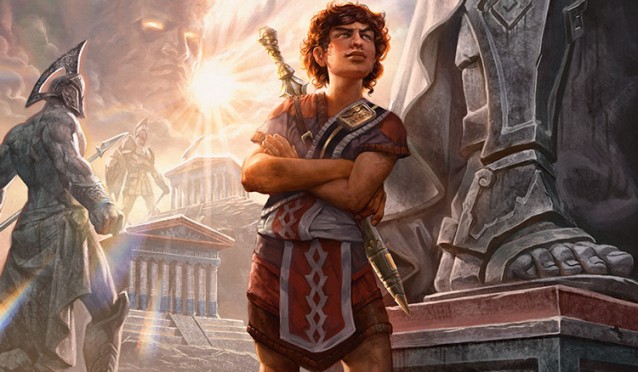
Of course, reasonable minds can differ, and there are those in the Magic community who believe that White Weenie decks are piles of unplayable garbage with no card advantage that roll over and die when the opponent manages the extraordinary feat of playing literally any creature or removal spell. Admittedly, there is a nugget of truth to this viewpoint, but the graveyards of Magic tournaments are littered with the bodies of those who overestimated their chances against a well-tuned aggro list. When the format reflects the belief that aggro decks are inherently inferior strategies, it’s White Weenie’s time to shine.
Are you interested in exploiting a gaping hole in the Modern metagame? Are you interested in an aggro deck that puts Burn and Affinity on the defensive? Are you interested in playing 16 copies of the best two-drop in the format for a single white mana (no, blue mages, I’m talking about Tarmogoyf and not Mr. Tiago)? Then maybe White Weenie, aka White Goyfs, is for you.
[wp_ad_camp_1]
The Road to White Weenie
Contrary to popular belief, there have been a number of White Weenie decks that experienced success at the highest levels. For Modern, Paul Rietzl’s 2010 Extended deck for PT Amsterdam stands out as especially relevant:
Extended White Weenie, by Paul Rietzl (1st, PT Amsterdam 2010)
I could point to a number of other successful White Weenie decks in years past (Craig Wescoe decks in particular naturally spring to mind), but one common theme is that they took advantage of a metagame that didn’t show them enough respect. I have always had the most success with White Weenie when it was a complete non-entity, or presumed to be strategically ineffective.
For example, if you played Standard in the fall of 2012, you might remember that Thragtusk was running rampant; UW control decks had access to both Supreme Verdict and Sphinx's Revelation; Reanimator combo was putting turn four Angel of Serenity into play and BR Zombies was taking down GPs. Opposing sideboards began to reflect the belief that BR Zombies was the only viable aggro choice, so naturally I sleeved up this beautiful disaster at GP Charleston:
Boros Weenie, by John Gniadek (30th, GP Charleston 2012)
In today’s Modern, there is a massive hole White Weenie is naturally built to exploit. There are essentially no decks playing sweepers (the natural predator of White Weenie decks since the beginning of time) in Game 1, and very few that run them in their board. Of the few that do, most of them are red damage-based sweepers such as Anger of the Gods or Pyroclasm, which are completely negated by Brave the Elements. The relative lack of sweepers means that overextending can’t be punished as badly as it needs to be. Additionally, rather than running cards that are generally strong against aggro decks, many sideboards have very specific slots dedicated to specific matchups: those Ancient Grudges, Stony Silences, and Kor Firewalkers accomplish virtually nothing against White Weenie.
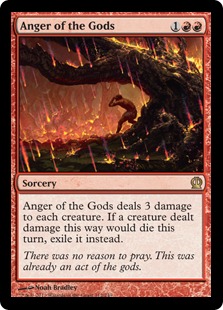 Due to the lack of sweepers, playing your first one-drop on turn one and two more of those one-drops on turn two leads to more free wins than you might expect. A timely spell on turn three can be backbreaking. I ran the numbers, and concluded that 29 creatures, 20 lands, and 11 spells is the optimal mix if you want at least three creatures, two lands, and one spell in your opener. For the mathematically inclined, this entailed running some multivariate hypergeometric distribution calculations. I worked backwards through trial and error to find the number of creatures, lands, and spells most likely to yield at least three creatures, at least two lands, and at least one spell in your opening hand.
Due to the lack of sweepers, playing your first one-drop on turn one and two more of those one-drops on turn two leads to more free wins than you might expect. A timely spell on turn three can be backbreaking. I ran the numbers, and concluded that 29 creatures, 20 lands, and 11 spells is the optimal mix if you want at least three creatures, two lands, and one spell in your opener. For the mathematically inclined, this entailed running some multivariate hypergeometric distribution calculations. I worked backwards through trial and error to find the number of creatures, lands, and spells most likely to yield at least three creatures, at least two lands, and at least one spell in your opening hand.
In Modern, white has an embarrassment of riches at the one-drop slot. In addition to roughly a dozen or so Savannah Lions variants, there are a surprising number of one-drops that get gigantic. Now, some of them simply don't have the support to consistently get there (Hada Freeblade), some require prohibitively too much mana to be remotely playable (Caravan Escort), and some require the deck to be warped around them for not enough payoff (Ardent Recruit). That still leaves nearly a deck’s worth of one-drop Goyfs to work with, which led me to the following decklist that I played at the Washington, D.C. Premier IQ:
Modern White ‘Goyfs, by John Gniadek (14th, SCG Premier IQ D.C., 2015)
There are a number of inclusions that will surely raise a few eyebrows, so in the next two sections, I wanted to offer my thought process on including each of them.
White Weenie: Maindeck
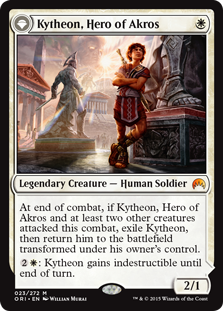 Kytheon, Hero of Akros: As it turns out, he’s the real deal and I would recommend playing the full four now. What people often overlook about cards like this is that, while perhaps unimpressive in a vacuum, they create increasingly complex decision trees that provide the opponent more opportunities to stumble. Imagine that you played a Lynx turn one followed by a Champion and Kytheon turn two. If your opponent only has one removal spell for their second turn, what are they supposed to do? Killing Kytheon runs the risk of taking a potential nine damage just from the Lynx and Champion on the next turn, but not killing the Kytheon runs the risk of you deploying additional threats with the ability to leave Brave the Elements mana open. A deck like this really maximizes Kytheon's potential since he threatens to become a 4/4 indestructible attacker as a natural consequence of the deck's primary gameplan.
Kytheon, Hero of Akros: As it turns out, he’s the real deal and I would recommend playing the full four now. What people often overlook about cards like this is that, while perhaps unimpressive in a vacuum, they create increasingly complex decision trees that provide the opponent more opportunities to stumble. Imagine that you played a Lynx turn one followed by a Champion and Kytheon turn two. If your opponent only has one removal spell for their second turn, what are they supposed to do? Killing Kytheon runs the risk of taking a potential nine damage just from the Lynx and Champion on the next turn, but not killing the Kytheon runs the risk of you deploying additional threats with the ability to leave Brave the Elements mana open. A deck like this really maximizes Kytheon's potential since he threatens to become a 4/4 indestructible attacker as a natural consequence of the deck's primary gameplan.
Steppe Lynx: Lynx requires the manabase to be built around him, but that doesn't cost you anything in this deck. Sometimes you don’t make land drops and the Cat just stands around not doing anything, but the ability to drop this on turn one and deal eight damage by turn three is nearly unmatched.
Champion of the Parish: He gives Steppe Lynx a run for its money as with some luck he can be a 6/6 on turn three. Once this becomes a 4/4 or bigger, many decks have major problems getting rid of it.
Boros Elite: I admit this card isn't very good, but it serves a purpose. Most opponents can’t keep you off of three attackers for as long as they’d like to believe they can.
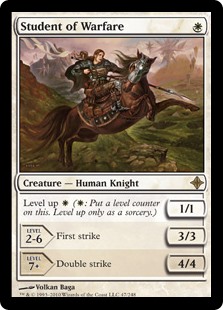 Student of Warfare: You usually don’t want to invest mana in this guy early; he's more of a mana sink/late game threat. While the leveling mechanic has traditionally been seen as unplayable due to the fact that you are often forced to choose between leveling or developing your board, this deck doesn't present the same issues. Due to the sometimes all-in nature of the deck, you will often find yourself hellbent by turn four with nothing else to use your mana on, and the inevitability of turning Student of Warfare into a 4/4 double striker means that opponents have to choose their removal targets wisely
Student of Warfare: You usually don’t want to invest mana in this guy early; he's more of a mana sink/late game threat. While the leveling mechanic has traditionally been seen as unplayable due to the fact that you are often forced to choose between leveling or developing your board, this deck doesn't present the same issues. Due to the sometimes all-in nature of the deck, you will often find yourself hellbent by turn four with nothing else to use your mana on, and the inevitability of turning Student of Warfare into a 4/4 double striker means that opponents have to choose their removal targets wisely
Figure of Destiny: I was originally skeptical, but this guy puts in a ton of work. Not being a Human hurts, however.
Soldier of the Pantheon: Both this and the next card are really only there as extra Humans to help reach a critical mass of creatures, but his protection from multi-colored can be relevant in many matchups (e.g. against Abrupt Decay, Electrolyze, Terminate, Siege Rhino).
Mardu Woe-Reaper: Again, just adds another Human body. The ability is sometimes relevant for shrinking opposing Goyfs or removing Scavenging Ooze fuel.
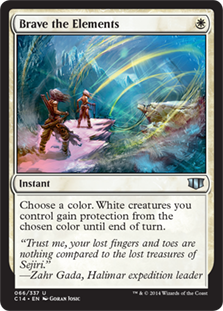 Brave the Elements: My vote for best card in the deck. Four may seem like overkill, but it enables you to go for broke with landfall or leveling and can be the topdeck you need to break a stalemate.
Brave the Elements: My vote for best card in the deck. Four may seem like overkill, but it enables you to go for broke with landfall or leveling and can be the topdeck you need to break a stalemate.
Path to Exile: While it’s the best removal spell in white (and possibly the format), giving them the extra land can be problematic.
Mana Tithe: While not a good card, it is a great play. Once your opponent knows it’s in your deck, you can side it out and they still have to play around it.
Arid Mesa, Marsh Flats, Windswept Heath: These could be any 12 fetchlands, as they are here purely to pump Lynx.
Plains: Eight is enough and possibly too many. Games in which you somehow run out of Plains are not games where you had a realistic shot at winning anyway.
White Weenie: Sideboard
Sunlance: In aggro mirrors, Sunlance is often just as effective at killing the creatures you care about as Path.
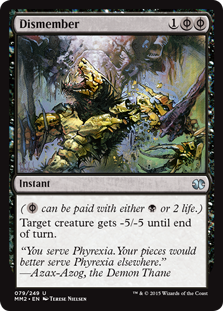 Dismember: Paths 5-7 against decks such as Splinter Twin and Infect. Sometimes you also need the extra removal against Grixis Control or Jund.
Dismember: Paths 5-7 against decks such as Splinter Twin and Infect. Sometimes you also need the extra removal against Grixis Control or Jund.
Angel's Grace: Originally the idea was to bring these in against Burn and Affinity. I seriously misevaluated the way the Affinity matchup plays out, but they still offer great insurance against Burn.
Grafdigger's Cage: These are solely to shut down decks that would otherwise win on the spot, like Collected Company combo. You wouldn’t bring them in against Snapcaster decks, for example.
Mardu Woe-Reaper and Kytheon, Hero of Akros: These provide a higher density of creatures against removal heavy decks.
White Weenie: Gameplay
In theory, the deck looks easy to play: play a creature turn one, then two more creatures on turn two, then as many creatures as you have left on turn three. Then win. While this deck is capable of generating easy free wins that way, you will lose a lot of games that you should have won if that’s the only approach you take. In most cases, you should be looking to keep an open mana up at all times from turn three on, and possibly even starting turn two, even as a bluff. If you are going to run a straight bluff, however, make sure that the opponent can actually afford to play around what you’re representing. If the opponent would just be dead if you have it, then do something else with your mana if possible.
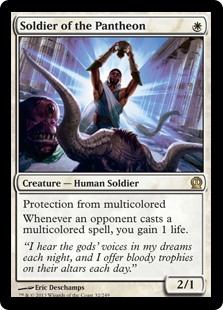 You should always keep track of when you can afford to throw creatures away in a chump attack, and when you need to stop attacking and play for a topdecked Brave. Generally speaking, if you stop attacking you lose, so it can often be correct to trade a Soldier of the Pantheon for a Lingering Souls token if it means getting in for five damage and flipping Kytheon.
You should always keep track of when you can afford to throw creatures away in a chump attack, and when you need to stop attacking and play for a topdecked Brave. Generally speaking, if you stop attacking you lose, so it can often be correct to trade a Soldier of the Pantheon for a Lingering Souls token if it means getting in for five damage and flipping Kytheon.
The decision whether to let one of your creatures get Bolted or save it with Brave the Elements always depends on the context of the game. For example, if you are attacking for lethal and the opponent is otherwise tapped out, of course you should play Brave, but if you still have an attack step or two to go and you have more threats in hand, it’s probably best to keep the Brave in hand.
Sideboarding should be kept to a minimum, and you should never be looking to side out creatures. For the most part you only want to side in cards that either win you the game on the spot or stop you from losing on the spot.
14th Place at the Premier IQ
After sleeving up the decklist, I took it to the SCG DC Modern Premier IQ with few expectations. I had a decent amount of experience with previous variations of the deck so I felt that I would pilot it well, but I had my doubts that a deck full of Boros Elites and Mardu Woe-Reapers could compete.
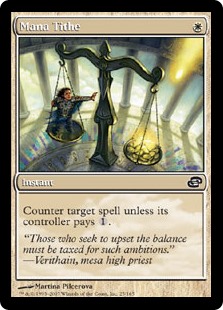 Round 1: U/B Faeries (2-1)
Round 1: U/B Faeries (2-1)
Game 1 was interesting as it took several turns to figure out what he was on. He was able to kill a few things and trade with flashed-in Faeries, but the game ended when he tapped out for Cryptic Command to fog me and I had the Mana Tithe. Game 2 I got him down to 3 before he stabilized, and I just couldn't muster enough pressure. Game 3 went about as well as I could hope: he got stuck on two lands early and I was able to dump my hand and crush him.
Round 2: Grixis Control (2-1)
Game 1 I rolled him over. He simply wasn't prepared to deal with aggro swarm, which is what I was counting on. Game 2 he ended up taking after drawing infinite removal and enough big creatures that I couldn't maintain any pressure. Game 3 I was able to draw just enough creatures that I was able to get there: he didn't realize that his sideboarded Vampiric Link was a triggered ability, so he died before gaining the life he needed.
Round 3: Grixis Control (2-0)
This match isn’t worth discussing. My opponent got a deck reg error game loss, and then mulled to five in Game 2 where I crushed him.
Round 4: Jund (1-2)
Game 1 my opponent stripped my hand of anything useful and cruised to an easy win. Game 2 I rebounded, drawing just the right mix of creatures and tricks to kill him on turn four. Game 3 was a bit closer than Game 1, but I wasn't able to find enough removal in time to get through the clogged board. My opponent ended up making Top 8.
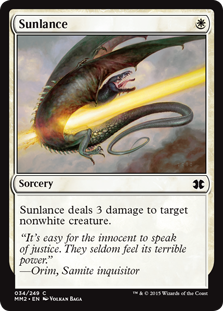 Round 5: Burn (2-1)
Round 5: Burn (2-1)
Game 1 was extremely close, but my opponent was able to draw enough spells to deal with some of my bigger threats while still pointing lethal burn at my face. Game 2 I was able to Sunlance every creature he ran out and eventually started deploying more threats than he had answers for. Game 3 was also extremely close, and we ended up in a situation where we were both topdecking, but my opponent knew I had an Angel's Grace thanks to a Goblin Guide reveal. Eventually I drew one more creature than he had burn for.
Round 6: Grixis Twin (2-0)
Game 1 I had Paths for both of his Exarchs, and I was able to play enough threats that he couldn’t deal with them all. He died with two Twins in hand. Game 2 was basically more of the same: he couldn’t afford to side out the combo because I was too fast, but that also meant he couldn’t bring in as much removal as he needed, and I overwhelmed him.
Round 7: Affinity (0-2)
This was by far the most interesting match of the day. Game 1 I had a gigantic board but he had too many blockers for me to push through. I made a strategic mistake and wound up getting punished for it: 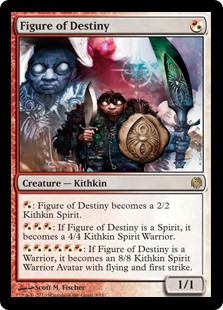 I failed to appreciate that the Affinity deck had a far superior late game, and was therefore uninterested in racing me. This miscalculation caused me to believe that trades were good for me, so I continued attacking rather than patiently pumping mana into Student of Warfare and Figure of Destiny with the plan of flipping an indestructible Kytheon in another turn or two. After several trades left his board decimated but me without my Figure of Destiny or Kytheon, a top-decked Etched Champion from my opponent left me with no realistic way of breaking through, and he was able to stay alive long enough to eventually put the game out of reach. Game 2 ended up being worse for me, as I didn't have removal for his Steel Overseer, and that in conjunction with Etched Champion and three or four Nexuses (both Blinkmoth and Inkmoth) spelled game over. This opponent also made Top 8, meaning both of my losses were to top 8-ers.
I failed to appreciate that the Affinity deck had a far superior late game, and was therefore uninterested in racing me. This miscalculation caused me to believe that trades were good for me, so I continued attacking rather than patiently pumping mana into Student of Warfare and Figure of Destiny with the plan of flipping an indestructible Kytheon in another turn or two. After several trades left his board decimated but me without my Figure of Destiny or Kytheon, a top-decked Etched Champion from my opponent left me with no realistic way of breaking through, and he was able to stay alive long enough to eventually put the game out of reach. Game 2 ended up being worse for me, as I didn't have removal for his Steel Overseer, and that in conjunction with Etched Champion and three or four Nexuses (both Blinkmoth and Inkmoth) spelled game over. This opponent also made Top 8, meaning both of my losses were to top 8-ers.
Round 8: Jund (2-1)
Game 1 I got out to an exceptionally fast start, and I had Brave for his last-gasp removal spell to win. Game 2 was a bit back and forth, but he was able to get two Goyfs up to 5/6 and I didn't draw enough gas to compete. Game 3 was similar to Game 1 in that I snap-kept something very close to a god hand, and had enough Braves to take it down.
It's worth noting that I won only one dice roll out of seven matches (I'm not counting Round 3, even though I lost that dice roll too). I probably won more games on the draw than on the play, which was unexpected.
White Weenie's Modern Future
While I was pleased with the way my tournament went, there are a number of changes I’ve already made to the deck. First, the deck needed more creatures and fewer spells. There were too many games 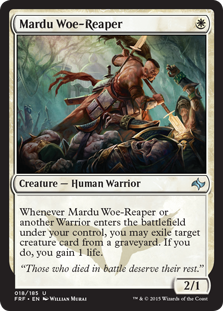 where I would run out of gas, or my hand would be Thoughtseized into oblivion, and I couldn’t generate enough pressure to stay in the game. As much as I love Mana Tithe, it needed to go to make room for more threats. I’ve since made the following changes to the main:
where I would run out of gas, or my hand would be Thoughtseized into oblivion, and I couldn’t generate enough pressure to stay in the game. As much as I love Mana Tithe, it needed to go to make room for more threats. I’ve since made the following changes to the main:
-4 Path to Exile
-3 Mana Tithe
-1 Plains
+1 Kytheon, Hero of Akros
+2 Mardu Woe-Reaper
+2 Dragon Hunter
+2 Dismember
+1 Flooded Strand
I also retooled the sideboard, mostly to adjust for my misreading of the Affinity matchup:
-3 Dismember
-2 Mardu Woe-Reaper
-1 Kytheon, Hero of Akros
-1 Angel's Grace
+ 4 Path to Exile
+2 Stony Silence
+1 Rest in Peace
In conclusion, the deck is very well-positioned in the current metagame. There aren’t enough sweepers seeing play to keep the deck in check, and the sweepers that do see play tend to fold to Brave the Elements. As an additional plus, if you already own the fetches and Kytheons, it's budget friendly. If you enjoy attacking for 10+ damage on turn three, like when your opponents have to stop to read the cards that are killing them, or if you love watching people’s faces twitch as you declare “I cast Modern-playable Mardu Woe-Reaper”, I highly recommend giving White Goyfs a go!
Editor's Note: Corrected a sentence in the introduction referring to Snapcaster Mage and Tarmogoyf.






Brave the elements is a fantastic card. I’ve run it in abzan “white zoo” decks with stuff like KOTR and tidehollow sculler – its excellent at getting those 7/7 kotr’s through without having to waste a turn fetching a wolf run or something and countering anger/pryoclasm (or just a terminate) for 1 mana is awesome.
Also love mana tithe but have yet to find a good home for it – sad to see it cut already from your list
Glad to hear you’re having success with Brave the Elements too!
Mana Tithe was my favorite card in the deck. At the end of the day, though, I just needed more creatures, and I’ve found Mana Tithe to be one of those cards that you add when you have extra slots, so it was the first to go.
The only question I have, and I see your comment about needing more Humans, is if you have test with/found room for Dryad Militant in the 75. I’m definitely excited to put this together, thanks for the write-up!
I like Dryad Militant, just not in this deck. It not being a Human messes with the internal synergies in the deck for what I think is not enough payoff. Figure and Lynx also aren’t Humans, but they also get gigantic. If there was a way not to run 2/1s in the deck that would be ideal, but since you’re forced to run them in order to reach a critical mass of creatures, I think they really need to be Humans in order to maximize Champion.
How about replace a copy of figure of destiny for isamaru hound of konda? I think cavern of souls can be an inclusion for the deck
The second point of toughness on Isamaru can certainly be relevant since it dodges Electrolyze, Lingering Souls tokens, etc., but my concern with it is that it will only ever be a 2/2, which is not big at all. Figure routinely gets to be a 4/4, at which point Bolt can’t kill it.
As for Cavern of Souls, it doesn’t produce White mana for Student, Figure, or the spells, and in my experience most decks running counterspells side them out against aggro decks, so the uncounterability isn’t as necessary. I’ve used it before in Humans decks, but I think this deck really needs the Plains.
But (and this goes generally for everyone) that’s just my opinion, and you are of course welcome to add your own personal touches!
I’ve been waiting for an article like this, especially given the current malaise that White decks in Modern seem to be under (plus it’s White Weenie, which is classic). I think this is a creative deck and that Brave the Elements is a great card (it’s certainly one of my favorites), but I have a few comments for you:
1. I think that if you’re truly focused on the “cast 1-drop creatures and spells” plan, you can get away with fewer lands – you probably only need 18 or so (even if that hurts the Lynx a bit). If you do stay on the 20-land plan, you should probably experiment with some 2-drops. Thalia in particular looks like it’d fit in well here.
2. No love for utility creatures like Dryad Militant and Judge’s Familiar? They strike me as being more useful than the likes of Boros Elite and Mardu Woe-Reaper, despite not being Humans. I know that pumping Champion of the Parish is important, but you don’t want to play bad creatures in the name of doing so. Also, if you have enough Humans, you can probably sneak Cavern of Souls in there.
3. I think Honor of the Pure is worth a test here because it speeds up your clock (and is a great late topdeck, provided you have creatures), and I’d like to see Ranger of Eos in either the mainboard or the sideboard in order to give you an answer against those attrition-based midrange decks looking to deplete your options. As a bonus, the Ranger is also Human.
4. I think Kataki, War’s Wage should be in your board in addition to Stony Silence. It may be a 2-drop, but multiple hard answers of that caliber are the only way I see your deck consistently beating Affinity. And while may have beaten Burn at the SCG, Kor Firewalker or Auriok Champion (if you insist on having a Human) would probably make your life a lot easier on that front.
Thanks for the kind words!
1. It’s possible that lands can be shaved, but in my experience, Steppe Lynx wants you to play a few more land than you need. As for Thalia, when I was first putting this article together, I actually devoted an entire section to explaining why I wasn’t including two cards: Thalia, and Honor of the Pure. Ultimately I decided it was better to focus on the cards that actually made the list, but I have played both Thalia and Honor of the Pure in previous versions of this deck and enjoyed success with both of them. The thing about Thalia is that, although you can cause the opponent to stumble, you can also do the same thing to yourself. One of the deck’s biggest strengths is the ability to add a threat to the board while still holding up mana for something like Brave the Elements. With Thalia out, you often can’t do that, and since she is only a 2/1 herself and costs twice as much as your other creatures, your clock is nowhere near as fast. I have a thread in the Deck Creation section of MTG Salvation’s Modern forum where I go a bit more into this decision.
2. Oh, I have love for them, I just don’t love them in this deck. The reason I call this deck White Goyfs is because Goyf is considered the quintessential “creature with just power and toughness,” and this deck is really looking for power and toughness rather than utility. For the most part, this deck is betting that the opponent isn’t prepared to deal with an extreme aggro rush, and playing utility creatures rather than beaters can delay your clock enough to give them time to deal with your threats. The other deck I run heavily is mono-White Death and Taxes, which are much better suited to run utility creatures like Familiar (my personal favorite for the deck) and Militant.
3. I talked about Honor a bit in number 1. above. I’ve run it before and it’s ranged anywhere from excellent to okay. Ultimately, 2 mana is a lot, and there’s not a lot of space, but I wouldn’t fault anyone for trying to run it. As for Ranger, when this deck briefly morphed into something very closely resembling Rietzl’s Amsterdam deck, I did run Rangers, but I was also running more lands and was more comfortable going to a late game. This deck as it currently stands is desperate to avoid the late game, but if I was looking for a Ranger-like effect for the sideboard, I might actually go for something like Immortal Servitude.
4. Kataki is certainly a possibility and is something I’ve strongly considered. There’s probably too much graveyard hate in the deck as is. As for Burn, I’ve previously run a few Kor Firewalkers and wouldn’t blame anyone for putting them in there (if you do, note that your Figures trigger your Firewalkers!), but I’ve actually found Burn to be a favorable matchup without them. This deck is faster than Burn, and they usually reach a point where they have to point their burn spells at your creatures. In addition, if you can get Champion or Figure into a 4/4, they really have no way of killing it without using 2 spells.
Thanks for taking the time to respond. I can see where you’re coming from with regards to cards like Ranger, Dryad Militant, and Judge’s Familiar. I’ll definitely be taking this deck as a template and putting it through its paces to see how far we can go with it. Thanks again, and I hope to read another article from you soon.
Did you ever consider running horizon canopy to refuel in mid & late games ?
I’ve definitely considered Canopies (as mentioned above, my other deck is Death and Taxes where I run 2 or 3 Canopies for this very reason), but I really think the fetches + Plains approach is the better way to go. You really want every land you draw to be a fetch when you have a Lynx out, so I think it’s best to have every non-Plains land to be a fetchland.
Hey everyone,
I just wanted to say thank you for reading, and thanks for the comments! As I mentioned in my bio, I’m a dad with a full-time job, and I just got home from work and want to play with the boys before they go to bed, but I promise I’ll come back later tonight and respond to everyone’s questions and comments. Thanks!
John
Hi John,
As a newcomer to the game (played for 6 months in late 90’s) with limited time for the very same reason as yourself I found this to be an excellent explanation (without jargon), well written, that I could follow through the logic and strategy.
Do you write anywhere else, or have a twitter feed? Please keep writing. It’s great stuff. BD, Scotland
Thanks for the kind words! I really appreciate the feedback. I think that while players on a monetary budget get a lot of attention (and rightfully so), there’s not quite as much content out there for those of us on a time budget. In theory, I’d probably be better off if I had the time to stay completely up to date on the metagame, the latest tech, constantly playtest the tier1-2 decks against each other, and develop the necessary muscle memory to pilot the top decks to top finishes. But that’s not my reality, and so I usually try to build my own decks based on solid theoretical principles and try to utilize my informational advantage when I go to one of the few tournaments I can find time for. When I sit down, I feel confident that I know more about my opponent’s gameplan than they know of mine, and a deck like this is built to try to take advantage of that information gap.
I don’t really write articles anywhere else (this is my first article), but I do spend a decent amount of time on the MTG Salvation forums. I most frequently post in the Modern Death and Taxes thread and on my own thread on this deck. I do have a twitter feed but very rarely post.
Thanks for the encouragement.
Guys i know the solution. Kessig malcontent
Since the mana tithe cut wheres the thalias? Human +first strike + hatebear
There was a super long comment I wrote above where I mentioned Thalia, so I’ll copy and paste that part since it’s easy for it to get lost:
The thing about Thalia is that, although you can cause the opponent to stumble, you can also do the same thing to yourself. One of the deck’s biggest strengths is the ability to add a threat to the board while still holding up mana for something like Brave the Elements. With Thalia out, you often can’t do that, and since she is only a 2/1 herself and costs twice as much as your other creatures, your clock is nowhere near as fast. I have a thread in the Deck Creation section of MTG Salvation’s Modern forum where I go a bit more into this decision.
Hey! First of all congratulations on such a great article, i am a rogue player deck at heart so seen decks like this makes my heart really happy!
I wanted to ask some questions that pop on my head and would love your input on.
1. How would you feel about a Green splash for Dromoka’s Command or a Blue splash for Meddling Mage for unfair combo decks or counter spells if needed. Given that we already have a mana base like this it shouldn’t be to hard to do it with a few hallowed fountain or temple garden.
2. How has Steppe Lynx performed for you? And how is the life management of the deck? With this i mean how hard would it be to splash.
3. Which decks would you consider are your toughest match ups and why?
4. I would probably would keep brainstorming on this since i have been looking to play something very similar for a while.
Thanks in advance!
Thank you! Glad you liked it!
1. I’m not opposed to a splash in general (and with 13 fetches, a splash is practically free, like you mentioned), but it would have to be for the right card(s). Personally I’m not crazy about 2-drops in the main: they cost twice as much as everything else, and they dilute one of this deck’s biggest strengths, which is the ability to take multiple “turns” each turn. Being able to deploy 2 real threats on turn 2, or even 2 mediocre threats on turn 3 with Brave the Elements mana open, is a real but temporary advantage that must be leveraged quickly, and once 2-drops start creeping in, the number of these kinds of starts starts to drop ever so slightly, as does the ability to leverage them. I would recommend keeping cards like this in the sideboard to start.
2. Steppe Lynx has probably accounted for more damage than any other creature (it’s in constant competition with Champion of the Parish) and has led to the most free wins. It’s the ideal turn 1 play, and even when you miss land drops you can still attack to flip Kytheon or trigger Boros Elite. Plus, if your opponent is running Path, it’s usually correct to swing with a 0/1 Lynx so that when they Path your best creature, you still get the 2 damage in (and for extreme scenarios where you have a Path of your own, you can Path one of your blocked creatures for the extra 2 damage). Life management is… okay, I guess, but generally not a concern. You usually present lethal faster than other fast decks (of note: this deck is not capable of a turn 3 kill, unless you get help from your opponent. I believe the most it can do is 18 damage by turn 3, and that’s with a triple Champion start and 3 more Humans on turn 3. However, the deck is often capable of presenting “super-lethal” on turn 4, meaning you can find yourself attacking for, say, 15 damage on turn 4 when they’re at 8). There’s also some incidental life gain (Soldier of the Pantheon and Mardu Woe-Reaper) that can add up. Another 2 damage here and there from a shockland isn’t going to be a problem.
3. Great question. I try to stay up on the metagame as best I can, but I just don’t have time for a lot of playtesting, so I’m mostly basing my matchups on theorycrafting. Long story short, I believe there are exactly 6 ways to beat aggro decks (3 when you get right down to it – possibly a future article topic?), and the toughest matchups are usually going to be those that diversify the way they beat you. There’s too many Tier 2 decks to give a comprehensive answer, so I’ll just do a quick run-down on the 7 Tier 1 decks (as identified by the good people of this site!):
Affinity: Unfavorable. Prior to actually playing against it I would have said favorable (and it still might be favorable against a version that isn’t running 4 Etched Champions main), but it turns out Affinity has a vastly superior late game and can deploy problematic blockers to help itself get there. Brave the Elements is practically useless here.
Jund: Slightly unfavorable. The fact that Jund diversifies its answers (both removal and large blockers) means it’s more difficult to neutralize how they beat you (quick note: I think it’s important with a deck like this to identify 3 things about your opponent’s deck: 1. how does your opponent stop you, 2. do you need to stop them from stopping you, and 3. if so, how can you stop them from stopping you?), but you have the tools to do it. The fact that Brave the Elements both counters removal and makes your creatures essentially unblockable is what makes it such a powerful card.
Burn: Slightly favorable. Generally speaking, anytime you can force a Burn deck to point its spells at your creatures, you’re likely to be in good shape. This deck does exactly that.
Grixis Control: Slightly unfavorable. Basically the same as Jund.
Merfolk: Favorable. Their better creatures don’t come down fast enough, and even with a lord or 2 they can still be smaller than your best threats. And of course, Brave the Elements naming blue wins the game on the spot.
UR Twin: Favorable. Sometimes they have the natural turn 4 combo and win the race that way, but if they don’t, they’re usually not packing enough removal to slow you down enough to dig for the combo.
Grixis Twin: Slightly favorable. Basically the same as UR Twin, except they are packing the removal they need to slow you down.
Again, I’m basing this mostly off of theorycrafting, but some of it is based on playing as well. If there are any other particular matchups you’re interested in, let me know.
4. Sounds good! Feel free to keep me updated, either here or on the MTG Salvation thread dedicated to this deck.
I disagree with the assessments on some of these matchups.
I’d call Jund about 50/50 with Kytheon’s ability to go indestructible and Student of Warfare’s first strike coming up huge, plus any deck that can neutralize the likes of Abrupt Decay and Maelstrom Pulse (via Brave in this case) and make Dark Confidant (mostly) a sacrificial blocker as opposed to a card advantage powerhouse is going to do at least OK against Jund. Note that these do not apply to Grixis Control, so I feel your assessment on that matchup is pretty spot-on.
I also think Merfolk will give you more issues than you anticipate – Brave is a huge trump card, but they pack counterspells (including Chalice of the Void, which can basically lock you out of the game), and Spreading Seas/Vapor Snag/Harbinger of the Tides can disrupt your tempo (especially if they bounce a Champion of the Parish or deny you a 2nd white source). And if they manage to do that, you’re in big trouble – their creatures are quite easily larger than yours, and tend to be harder to block. Furthermore, they’re less likely to run out of gas because of all of the native cantrips they have (8 to your 0). I’m not going to say that they’re favored against you (the speed of White Weenie is definitely a concern), but I’ll say that it feels 50/50.
I’d also like to hear what you think of the Tier 2s – a quick glance tells me that Grishoalbrand could be tough for you without something like Rest in Peace or Mana Tithe, and that Elves’ linearity could also pose a problem. On the other hand, RG Tron has to pray for Pyroclasm or be overwhelmed, and Abzan is probably weaker against you than Jund is.
Jund: I’d agree that Jund is probably a sliiiiightly better matchup than Grixis, and 50/50 might be closer to correct. My experience has been that despite White Goyfs’ redundancy, Jund’s discard can completely destroy our hand. It could be that moving up to 34 creatures from 29 moves those percentage points up enough, but I agree that it does feel a bit coin-flippy.
Merfolk: you may be right. I haven’t played this matchup in a while, so I’m mostly trying to use my experience with the Merfolk vs. Death and Taxes games I’ve played recently and extrapolate from there. I think early disruption is crucial from the Merfolk player; otherwise, I think their lords come down too late to matter. Chalice is an evil card, but unlike something like Engineered Explosives, it doesn’t clean up what’s already been dumped onto the battlefield. The hope would always be that the Merfolk player never draws it, of course.
I agree that Grishoalbrand would be a problematic matchup. You have some tools to deal with it in the sideboard, but all-in combo has never really been a good matchup for aggro swarm. Elves also feels like it would be at least slightly unfavorable. I’ve had some success against Tron, but it’s tricky trying to balance playing around Pyroclasm/O-Stone while also trying to kill them quickly. Wurmcoil Engine is also a problem, but Karn not so much. I actually think Abzan could be a worse matchup than Jund: this deck has a number of draws that have trouble against Lingering Souls, especially if they’re on the play.
I wish I had more time to playtest the deck and give more concrete answers on the matchups, but I just don’t have that much free time on my hands anymore. I’m lucky if I can get out to my LGS every other week to battle in a 12-or-so person Modern tournament. Regardless, I would pretty much always rather be on the side presenting the threats rather than being on the side that has to try to draw the right answers (usually costing more mana) on time.
Wow! That was awesome, thanks for the detailed answers!
I will get some free time today to start testing, is great to know how good is the Lynx!
Thanks for the article and great deck!!! I proxied up your version and decided I wanted to build this! I had a couple of ideas and wanted to get your opinion on it. I agree with your cut of Mana Tithe it only seems good game 1, and loses value fast. I was thinking of a blue splash (1 hallowed fountain) for either spell snare or spell pierce, with dispel in the sideboard. I was also looking at Days Undoing as a two of. I haven’t tested it yet, but it seems like we get to take advantage of that effect the best/most efficiently. The mana cost is prohibitive though.
Another thought I had was a red splash. There have been a number of games where the opponent is down to 2 or 3, and Lightning Bolt seems awesome for a little reach/Sunlance replacement out of the board. Maybe splash both?
Thanks! A splash seems reasonable, though I’m not sure that the extra 2 damage off of a shock is worth the upgrade over Mana Tithe to a Spell Snare or Spell Pierce. My gut says that Day’s Undoing would be better as a 1-of, and even then I’m not sure it’s worth it. 3 mana is a ton in this deck.
Red also seems like a good choice, and Bolt would be one of the obvious reasons. White Weenie with reach has been a good combination for me in the past.
How important are the fetches to the deck, and will the deck still function without them, or any white fetches at all?
Also awesome write up, congrats on your finish!
Thanks!
Fetches are pretty crucial, since they power up Steppe Lynx. If you took out the Lynx, you wouldn’t need to run any fetches, but that’s a huge sacrifice. Lynx gets in for a ton of damage in this deck, and cutting it means Champion is really your only potentially explosive turn 1 play.
Great article! I’m looking to build this deck myself.
Have you considered adding two Temple Garden so that you could play Warden of the First tree?
It’s human and it pumps with white mana.
I’m building this in paper myself and might test out Warden.
Glad to hear it! I have a thread on MTG Salvation on this deck (it’s in the Modern Deck Creation section, called Mono-White One-Drop Goyfs), so that might be a better place for future collaborative discussion on the deck itself.
As for Warden of the First Tree: I think it’s more in line with the deck’s original intent than some of the other splash suggestions (it’s a 1-drop Human that gets bigger than a Savnnah Lions, which this deck is always on the lookout for!), but it’s not without its own downsides. It doesn’t get protected by Brave the Elements, which I think is actually pretty significant, and the 3/3 vanilla body, while large, is probably sliiiightly too small for the mana cost, and given the amount of mana it would take to get bigger (especially considering that the trample/lifelink don’t increase power or toughness), I don’t think you’re realistically getting it bigger than an active Boros Elite. It would obviously be better on defense once you’ve activated it the first time, but overall I’m not convinced it’s worth taking the 2 damage from Temple Garden.
But definitely give it a try if you want! I don’t have the time to tinker around too much with the deck, so I tend to try to stick to core theoretical principles as much as possible, but I’m sure there’s plenty of room for experimentation.
Those are all really good points.
Thoughts on Jötun Grunt as a way to control graveyards and get a quick beater in?
Honestly, I’m not crazy about it, but I can understand why it’s appealing. Generally speaking, you don’t want to board in value cards, so if you’re bringing in graveyard hate it should be to win the game more or less on the spot.
The funny thing about Grunt: even though it has an excellent power-to-card ratio, it doesn’t have a particularly impressive power-to-mana-cost ratio. For the same amount of mana, you could play 2 Mardu Woe-Reapers, which are thoroughly unimpressive, and be representing the same amount of damage. Yes, that’s 2 cards instead of 1, but that’s actually going to be beneficial for you more often than not (pumping Champion, turning on Boros Elite/Kytheon, etc.). I think there’s a temptation to play “good cards” in a deck like this, but when the deck is as sensitive to its internal synergies as this one is, it’s often better to play “bad cards” if they work better with the deck’s plan. I mean, take another look at Ornithopter’s text: it is an atrocious Magic card, but it is crucial to Affinity’s synergies.
Great points here. I’m looking forward to reading more of your articles!
Hey! Have you considered a red splash for Lightning Bolt, Boros Charm, Monastery Swiftspear and Abbot of Keral Keep? Not for the prowess, but for the ability to let you go into combat bluffing tricks (or not bluffing cause you might have them) cast more dudes off the top without having to lose hand density and being able to have reach and close matches faster?
If I was going to splash, I’d probably start with red to test out adding burn to the deck in place of the Dismembers and Braves, but I’d probably leave the creatures alone. I’m not crazy about Swiftspear in a 6-spell deck, and once you start cutting creatures for more spells, you’re making Boros Elite/Kytheon worse, and if you start cutting those for more spells, you’re making Champion worse, and if you start cutting those for more spells, you really ought to playing Burn at that point.
Have you thought about 1 or 2 Return to the Ranks in the sideboard?
Finally read this article! Hope you’re still brewing and tweeking! Catch you in the forums soon?
-Catmix
Hello!!!!! First of all, it’s a beautiful deck. My girlfriend sleeved this up and she’s doing it great

One question: what do you think about Hada Freedable and Kazandu Blademaster for the deck, now that they have Expedition Envoy to grow????
Sorry for the bad English, I’m from Argentina.
Keep rocking it!!!!
Sorry I didn’t reply to this earlier!
I don’t think the Ally subtheme is supported enough yet. Blademaster is good, but I have a strong aversion to 2 drops in a deck like this, and I don’t feel there’s a strong enough payoff. If we get another solid 1-drop Human Ally in Oath, though, then I would strongly consider running it, Freeblade, and Envoy in place of things like Soldier of the Pantheon and Mardu Woe-Reaper.
Hey I really want to try this deck but Honestly the fetches are too expensive for now and I would preffer to get everything else, what could I replace? I already took out the lynxes and added enough plains to cover the 20 mana base, I replaced the Lynxes with Honor of the pure, is there anything that you would recommend as far as mana base and replacements for lynx?
If you aren’t going to play Lynxes and fetches, then I would actually recommend you drop down to 18 lands and possibly 16, though I haven’t tested 16. The only reason to run 20 lands is to power up Lynx, and having fetches effectively means you’re not really running 20 lands anyway. Without fetches, 20 lands is overkill.
Lynx is a very tough card to replace, as it is the single most explosive turn 1 play White has access to. It’s a bit like playing Burn without Goblin Guide, or Zoo without Wild Nacatl. I think Honor of the Pure is actually a pretty sensible replacement, since your hope is to compensate for the loss of a more explosive turn 1 play with a global pump ability. It’s possible you’d be better off running more 1 mana 2/1’s in its place, or even something like Accorder Paladin, but Honor would probably be my first try.